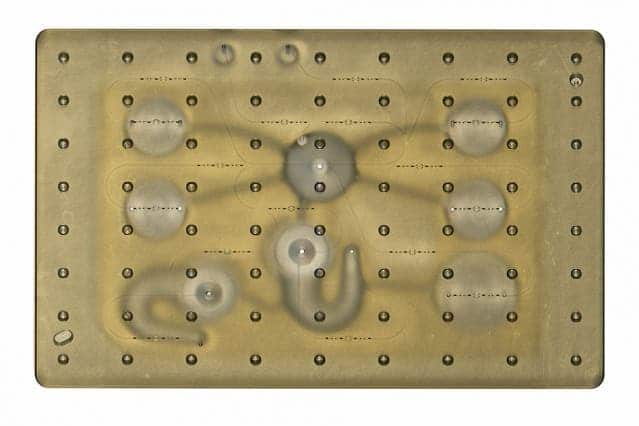You may have heard of organs on a chip, but have you heard of a body on a chip? MIT researchers have developed a platform that connects engineered tissues from up to 10 organs, accurately replicating the interactions between these organs.

Image: Felice Frankel / MIT.
Testing drugs is no easy task — you not only have to ensure that the drug is working, but you also need to make sure it is safe and not causing any unwanted side effects. Drug testing typically involves animal testing (which can bring significant pain and suffering to the animals), followed by human trials. In order to reduce the time, costs, and suffering brought by testing, researchers have recently developed so-called “organs-on-a-chip.”
Much like the name implies, an organ on a chip is a cell culture chip that simulates the mechanical and physiological characteristics of an organ. However, organs aren’t isolated machines operating in a void — they constantly interact and exchange substances with other tissues and organs, with major consequences for their overall behavior and, consequently, for drug testing.
However, until now, scientists didn’t have the tools to replicate these interactions. This is where the new MIT chip comes in, offering a way to look at the broader picture:
“Some of these effects are really hard to predict from animal models because the situations that lead to them are idiosyncratic,” says Linda Griffith, a professor of biological engineering and mechanical engineering at MIT, and one of the senior authors of the study. “With our chip, you can distribute a drug and then look for the effects on other tissues, and measure the exposure and how it is metabolized.”

It’s not just that this technology could reduce the need for animal testing for the sake of eliminating unnecessary suffering, but it could actually have better results. Animals are imperfect models for human drugs, and this has become more and more apparent in recent trials, Griffith says. Furthermore, due to physiological differences between individual patients (genetics, environment, lifestyle), some problems of these drugs might fly below the radar.
“A lot of the time you don’t see problems with a drug, particularly something that might be widely prescribed, until it goes on the market,” Griffith says.
The researchers created several versions of their chip, linking up to 10 organ types: liver, lung, gut, endometrium, brain, heart, pancreas, kidney, skin, and skeletal muscle. Each “organ” consists of clusters of 1 million to 2 million cells. Of course, this isn’t an exact replica of the entire organ, though it does perform its primary functions. The technology can be scaled and adapted depending on the desired configuration.
Source: MIT.


